A Guide To Chef Kitchen Knives Types, Uses And Their Maintenance
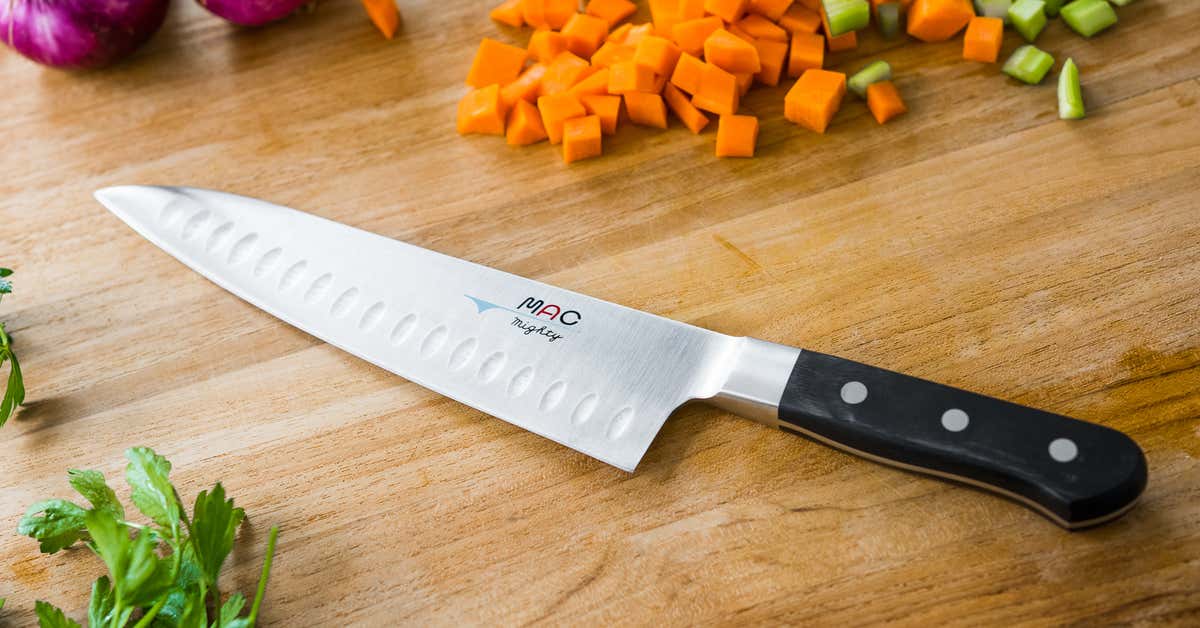
While I own a chef’s knife, I’ve always been curious about why chefs choose specific knives and why a chef knife is excellent for not just what I do with mine but also for many more applications. So I decided to conduct research and write a comprehensive guide on chef knives, explaining all there is to know about them, including how to use, sharpen, and choose one.
A chef’s knife is an all-purpose knife that ranges in length from 8 to 12 inches and is used for slicing, mincing, and dicing vast amounts of vegetables, breaking down a whole bird, and carving and slicing neatly sliced portions of meat. Sharpening is only required a few times a year; however, the blade should be honed every week.
But there’s a lot more to learn about chef’s knives. It includes how to care for them, sharpen them, whether or not to wash them in the dishwasher, and how to choose one that’s right for you.
So, let’s dive into the world of chef’s knives and discover everything there is to know about them!
What exactly is a chef’s knife?
The most common knife used by chefs is the chef’s knife. Although they may have additional blades in their arsenal, the chef’s knife is the most commonly used all-purpose knife for slicing, chopping, and mincing vegetables. A knife for chopping meat takes apart an entire chicken, cow, lamb, or another animal (separating the different cuts from one another); garlic is smashed using the blade’s flat edge. But that’s only a sampling of what cooks can achieve with a chef’s knife.
A chef’s knife is long, usually at least 8 inches long and up to 14 inches long. It usually has a pointed tip, and the blade is about 1.5?? wide from the top of the sharp edge. Stainless steel is commonly used, but ceramic can also be used.
Chef knives most likely originated in France. However, today you may find excellent knives made in Germany and Japan, and they can also be referred to as cook’s knives.
Each section of a chef’s knife is given a different name
- The upper section of the blade closest to the point is called the tip.
- The end of the blade, when it comes to a point, is known as the point.
- The sharp side of the blade is known as the cutting edge.
- The larger and slightly duller end of the cutting edge closest to the handle is known as the heel.
- From end to end and short side to dull side, the entire blade is referred to as the blade.
- The spine is the blade’s dull side (the top side).
- The thicker metal component that links the blade to the handle is called a bolster.
- The long protruding section where you grip the knife is called the handle (maybe one piece, have wood sides riveted on, or could be a separate piece attached to the blade).
What is the ideal thickness for a chef’s knife?
In the end, you want the blade to be as thin as possible while remaining strong.
If the blade is too thin, it may shatter when cutting thicker or tougher meats or veggies, and it won’t cut things neatly if it’s too thick. A tomato, for example, will be squashed by a blade that is too thick (or too dull of a blade).
Unfortunately, not all chef’s knives specify the thickness, and the blade does get thinner as it approaches the tip. It can alternatively be written as a decimal, a fraction, or even a metric.
Knife blade thickness is a little perplexing.
However, most chefs tend to agree that a chef knife’s thickness should be between 3/16 and 3/32 inches. These correspond to a thickness of .1875 to .09375 in decimals. After all, a thick chef knife may be ideal for breaking down a chicken. Still, it won’t be ideal for slicing anything more delicate, such as newly smoked brisket. Of course, a competent chef will have a large number of knives, each of which will be specifically suited to a given purpose, and, as a result, each knife will have the ideal thickness for that activity. A cleaver, for example, which helps cut through bones, can be thicker than a carving knife, which is suited for much more delicate tasks needing greater precision. We need to establish a suitable balance between power and flexibility for the home chef who can only use a chef’s knife.
You may want a thicker blade if you are stern with your knife and do much swaying back and forth when chopping vegetables.
What knives are required by chefs?
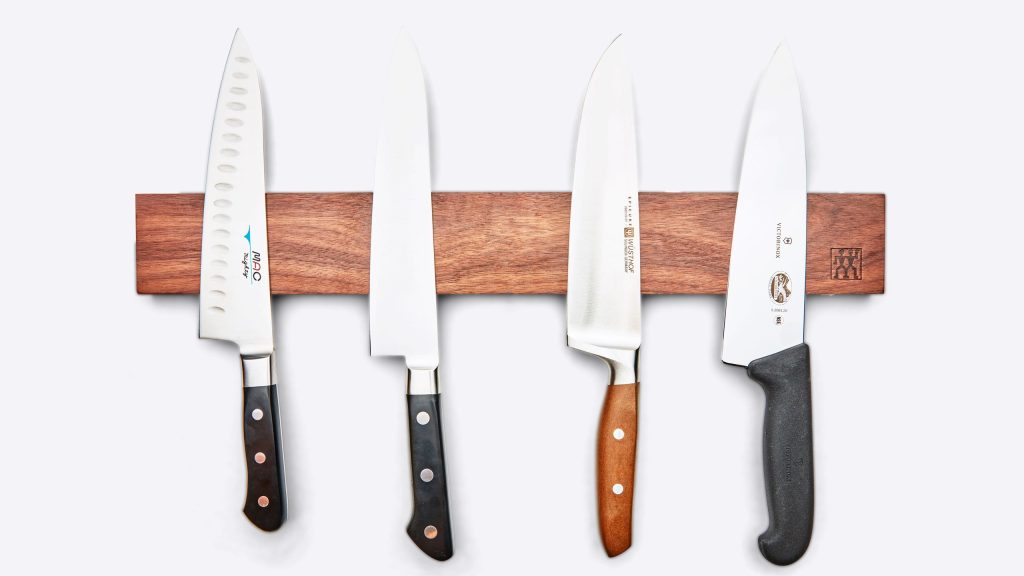
Keep in mind that a chef’s knife and a bread knife are sufficient for the home cook. If you’re ready to upgrade your kitchen knife set, try the following five knives that most expert chefs consider essential
Paring knife — For mincing and dicing small objects like garlic and peeling fruit and tender vegetables. They’re mostly under 4 inches long, so they’re best for more minor, more detailed work.
Serrated/bread knife — This is a must-have for slicing baguettes or other hard, crusty bread. A slick blade, such as a chef’s knife, will not cut bread effectively. However, they’re also fantastic for melons, peppers, and cake. Essentially, the jagged edge.
Boning knife - For removing meat from bones in any meat, poultry, or fish. The blade is narrower and thinner than a chef’s knife, making it ideal for bending around difficult places that aren’t entirely straight. Use caution when cutting through bone.
Cleaver: The cleaver is under-appreciated because nothing beats a good cleaver for cutting through the bones of an entire chicken. The blade of the cleaver resembles a rectangle with a handle on one end. It’s not as long as a chef’s knife (usually 6??-8??), and the blade is much thicker, making it ideal for swinging down hard on a chicken bone.
Chef’s knife — The most commonly used multi-purpose knife in both home and professional kitchens.
What is the purpose of a chef’s knife?
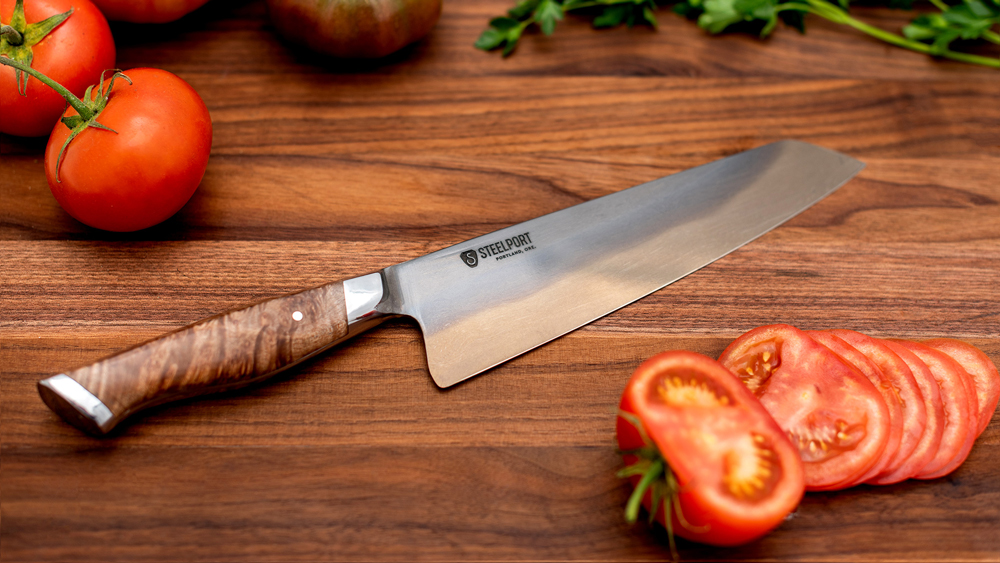
My chef’s knife is my go-to tool for just about everything. I have a serrated knife, a paring knife, and a cleaver, but I use my chef’s knife 99 percent of the time when I’m cooking. I use it to slice and dice onions, garlic, peppers, potatoes, and carrots, among other things. But I also smash garlic cloves with the flat side of the blade, and it’s fantastic for slicing tomatoes (with a nice sharp blade). Are you going to make coleslaw? Rather than buying pre-shredded cabbage bags, opt for a whole head of cabbage (which is significantly less expensive). After removing the usually filthy and unsightly outer leaves, cut the cabbage in half and, working with one half at a time, begin thinly slicing the cabbage from one end to the other with your chef’s knife.
Freshly shredded coleslaw mix is ready in under a minute. But that’s only the start.
A chef’s knife can also be used for the following tasks:
- Chopping raw meat into cubes or strips.
- Slicing cooked meat (always wash raw meat after cutting it).
- Fresh herb chopping (basil, cilantro, rosemary, etc.).
- Smaller bones are cut through.
- Nuts to chop.
- Most fruits and vegetables can be sliced or cubed.
- But I also use my chef’s knife to slice beef, poultry, and sausage straight from the grill, and it’s also fantastic for removing corn kernels from the cob.
To do so, I hold the ear of corn with the tip in a large bowl, pointing up. I slice down along the corn, getting the blade of the knife as close to the cob as possible. Then with my left hand keeping the ear in place on the very top. A competent chef’s knife, on the other hand, has an almost limitless number of applications.
What is the ideal length for a chef’s knife?
In the end, the question of how long a chef’s knife should last boils down to
- Individual preference
- Cooking experience
- How long and mighty are your arms?
- Cutting boards and countertops of various sizes
- Chef knives with a length of 12 inches are popular among professional cooks.
Expert chefs prefer a longer blade because it allows them to slice, dice, or chop a more significant amount of food with each stroke. At the end of the day, the more food you can prep with each movement, the more efficient your kitchen will be. So, if you’re Gordon Ramsey, and you’re cooking at his three-Michelin-star London restaurant, you can bet that every movement counts!
However, the longer blade will be heavier, and it means that you’ll have more arm strength. If you work in Gordon Ramsey’s kitchen, you’ve probably diced thousands of pounds of vegetables and developed incredible arm strength and endurance.
However, the home cook is unlikely to have done so. A home kitchen counter will not be nearly as deep as a professional kitchen prep table, which is also true. The same can be said for cutting boards used at home.
As a result, for most home chefs, a 12?? chef knife isn’t going to be the best option. So, for the majority of us who enjoy cooking at home, an 8-inch chef’s knife is the best option. It strikes a good mix between being long enough for most jobs and being light enough to accommodate most people’s arm strength and endurance. It also works well on a standard cutting board and kitchen counter.
Chef knives can be washed in the dishwasher?
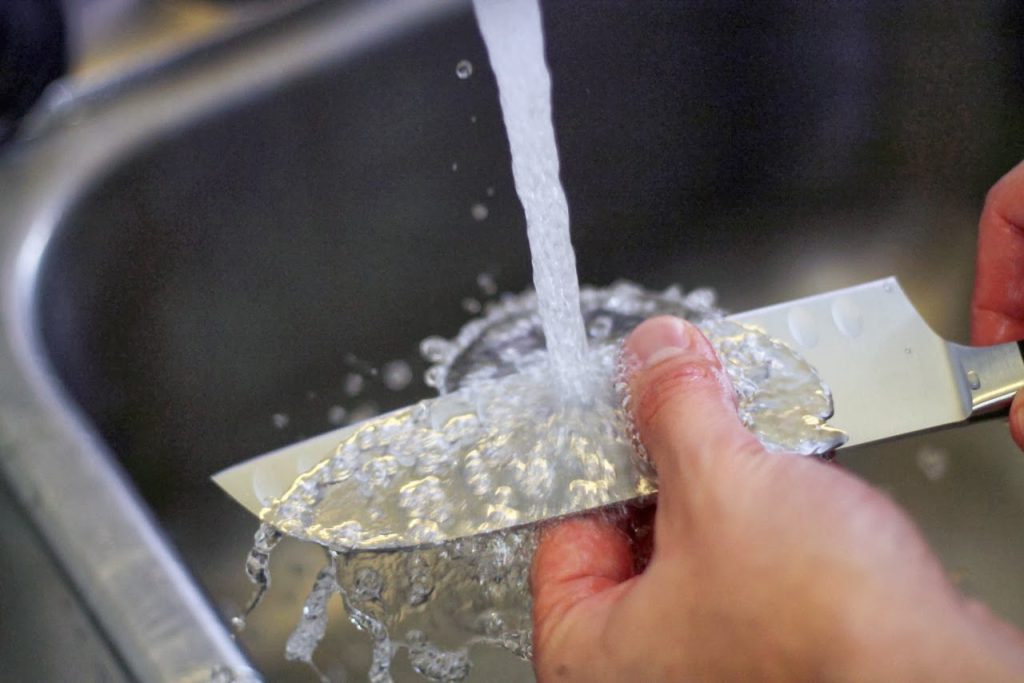
In the end, the answer is yes, but you should avoid washing them in the dishwasher. Many knives, particularly those purchased at places like Target or in a set with a wooden holder, may state that they are dishwasher safe. As a result, you’re undoubtedly tempted to throw them in the dishwasher and call it a day.
Dishwashing a high-quality chef’s knife has two adverse effects:
If it has a wooden handle, the wood may gradually fade, degrade, and possibly rot.
The abrasive detergent and possible blade banging will cause the blade to be dull significantly more quickly.
While blades will constantly become dull over time, sharpening a blade grinds a tiny portion of it away. It’ll eventually be so ground down that you’ll need a new knife. So, while a razor-sharp knife is desirable, you don’t want to sharpen it more frequently than necessary.
So, the easiest way to clean a chef’s knife is to do precisely what I do with mine every time I use it. I use a scrub brush with a long handle and a small quantity of dish liquid on the scrub pad. Then I scrub the knife up and down and along both the sharp side of the blade and the dull top side of the blade with hot water while holding the knife by the handle. After that, I rinse and let it air dry.
I only use the long-handled scrub brush for safety reasons, so I can clean the sharp side of the blade thoroughly without risking cutting myself. So, no matter what your chef knife says when you got it, wash it by hand every time you use it if you want it to last (mine are almost 20 years old and still as lovely as the day I bought them).
What is the proper way to handle a chef’s knife?
The way you hold your chef’s knife is critical for both the quality of your cuts and the safety of your hands and fingers. You can quickly produce imprecise cuts if you hold the knife wrong. If you’re chopping potatoes and your cuts are haphazard, you can wind up with some chunks that are substantially larger than others. The components will then cook unevenly during the cooking procedure.
In the end, this will have an impact on the quality of the food you prepare.
So, to ensure that you can cut swiftly, efficiently, and securely, let’s go through how to hold a chef’s knife.
For the knife-wielding hand
Maintain a firm grip on the handle and avoid getting too close to the blade. Your fingers will curl around the handle, while your thumb will press against the opposite side of your fingers, providing stability and control.
To avoid rolling or slipping as you make more cuts, cut vegetables in half first - either round or even.
When smashing garlic, set the blade flat on the cloves and merely maintain the handle in place with your holding hand. Your fingers will not wrap around the handle.
Keep the tip of the knife in touch with the cutting board as you rock back and forth for mincing.
A few tips for the other hand
Curl your fingers in towards your palm as you hold the food item to be cut, so your fingertips aren’t near the blade with your other hand.
You press your knuckles against the flat side of the blade with your thumb inside the fingers (like a loosely closed fist) (not too close to the sharp side). This allows you to adjust the distance between the food and the blade.
Chefs sharpen their knives in several different ways
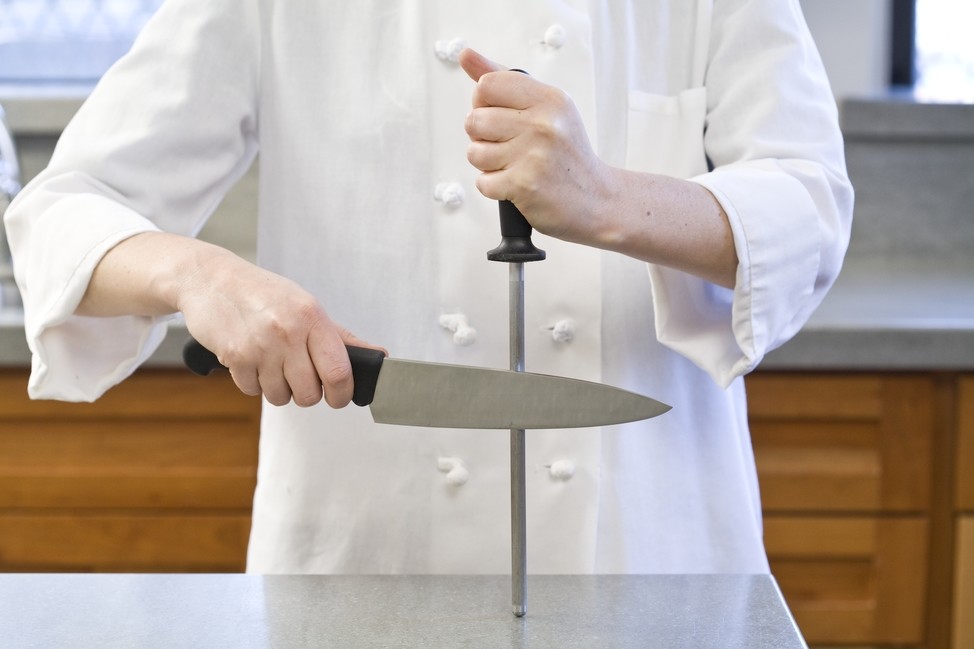
Sharpening knives is a topic that causes many misunderstandings among individuals, particularly home cooks. I can’t tell you how many times I’ve gone to friends’ houses and seen good chef knives in their collection that were dangerously dull.
A growing number of professional kitchens are turning to a knife sharpening service. Someone comes to their kitchen regularly and sharpens everything on the spot. At the very least, most professional chefs use a sharpening stone at home. There are a variety of fancy diamond sharpeners and other gadgets available, and some of them are pretty useful. However, for professional chefs, there’s no replacement for gently and consistently pulling the blade across a somewhat damp sharpening stone at a 15-30° angle, alternating sides every 3-4 strokes.
Ensure that each pull is done with the same amount of force, at the same angle, and from the heel to the point of the blade. Sharpening stones with a rougher side and a smoother side are available. If your stone has two sides, begin by swiping the knife across the rougher side many times before moving on to the more delicate side. It should be roughly ten times on either side of the stone. Check the sharpness, and if it’s good, start sharpening right away with your sharpening steel (more on that below).
The bevel is the angle at which the blade is angled. The sharper the knife, the smaller the angle/bevel. The wider the bevel, though, the longer the knife will generally last.
Is it true that a sharp knife is more deadly than one that is dull?
A dull knife, contrary to popular belief, is significantly more hazardous than a sharp knife. The reason for this is that cutting through something with a dull knife takes a lot more effort and arm muscle. If you push or shove your knife far harder than you should, it is much more likely to cut or poke you significantly if it slips. A razor-sharp knife, on the other hand, will slice through practically anything with ease.
Are you unsure how often you should sharpen and hone your chef’s knives?
You’re not the only one in that situation! In the end, it comes down to what you’re cutting, how frequently you use it, and how hard the steel used to build the knife is.
Is there a difference between sharpening steel and a sharpener?
I’m not sure there’s anything more perplexing about sharpening kitchen knives than the so-called sharpening steel. This is because, despite its name, sharpening steel will never, ever sharpen a dull knife. As a result, in addition to a sharpening stone or sharpener, you’ll need sharpening steel. After you’ve honed the blade, you utilize the sharpening steel.
Let’s have a look at how they complement each other.
A sharpening steel is a piece of steel with a long, round, and smooth handle. It doesn’t come to a sharp point at the end, but it does taper. We’ve all seen culinary contenders frantically swiping their blades up and down the steel with their knives.
However, as I already stated, a steel (let’s stop calling it sharpening steel) will never sharpen a dull knife. On the other hand, steel is used to hone the blade once it has been sharpened.
So, these are the distinctions between honing and sharpening:
Sharpening (done just when you discover that your knife is dull; not every time you use it) – The blade is ground at an angle, removing small portions of the blade. Sharpen the blade a few times a year or whenever you see it becoming dull.
Practice sharpening 1-2 times a week depending on how often you cook). Essentially, you’re moving the tiny fragments of metal on the knife blade’s sharp side back to the blade’s center. While honing does not sharpen the blade, it does make it appear sharper because the blade is perfectly centered.
Please don’t overdo it when it comes to honing.
Run as fast and far away, if you witness a chef honing his knife 10-20 times. They don’t know how to care for their knives properly and hence are unlikely to be well-trained in the kitchen. Only a few wipes are required.
Place the steel in front of you, with the tip pressed against a cutting board.
Then, with a firm grip on the steel, swipe down with the knife at roughly a 15° angle, the sharp side of the blade against the steel. Start at the top of the steel with the knife heel, sliding down as you pull the knife back to the point.
Then repeat the process on the opposite side. We want the blade to be even and centered, so we never repeat the same side repeatedly before switching to the other side. At first, apply intense pressure before gradually easing off.
What distinguishes a Santoku knife from a chef’s knife?
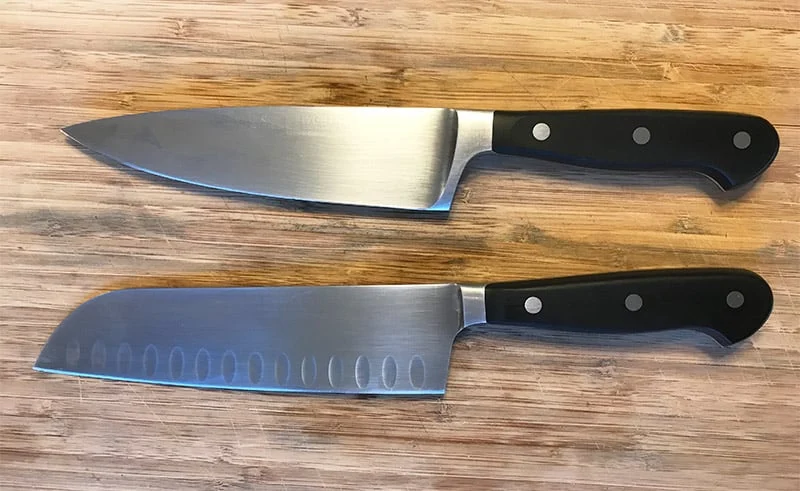
A Santoku knife is simply a chef’s knife from Japan. It is, however, usually much shorter than traditional chef’s knives, ranging from 5”-7?? to 8??-14?? in length. The indents that run the length of the blade at the sharp edge are one of the most noticeable characteristics between a Santoku knife and a chef’s knife.
This is known as a Granton edge, and it’s essential because the scalloped indents generate tiny air spaces between the food and the blade, which helps the food stick to the knifeless. Finally, these scalloped indents enable more exact cuts with less of a ragged edge, which is especially handy when slicing fresh fish for sashimi, where presentation is everything.
The tip is the other significant distinction.
A chef’s knife usually has a tip that protrudes from the blade’s center, but a Santoku knife curves down and the point is almost entirely aligned with the blade’s bottom sharp edge.
Why is a chef’s knife made of Damascus steel?
If you spend enough time in the chef knife world, you’ll hear the word Damascus steel.
Is Damascus steel a superior material to carbon steel? Let’s have a look. Chef knives made of carbon steel are relatively prevalent. If you already have one, it’s most likely constructed of carbon steel. Carbon steel is tough by nature. This means it can hold its sharp edge for longer and cut more precisely.
Another advantage is that carbon steel chef knives are generally inexpensive.
The main disadvantage of carbon steel knives is that they might rust with time because they are not made of stainless steel. As a result, cleaning, drying, and caring for it takes a little longer and is more vital than other types of chef knife materials.
Damascus steel is just the name given to a steel-iron alloy. Damascus steel has been around for hundreds of years, so it is not a new technology. Still, it is highly sought after, making Damascus steel knives more expensive.
Another fascinating thing about Damascus steel knives is that no two are alike, making them collector’s goods and almost like pieces of art. In the image above, you can see the one-of-a-kind pattern.
Most chefs, in my opinion, use carbon steel chef knives, albeit they may have a prized Damascus steel knife on display at home. However, as with anything in the food business, you can always find someone doing something different.
Carbon steel chef knives are still the best choice for most of us on a budget because they are almost usually over $100 and many outstanding ones cost north of $500.
Which chef’s knife is the best?
“Best,” like everything else in life, is a highly subjective concept. What Gordon Ramsey considers “best” will undoubtedly differ from what I consider “best.” For one thing, he knows a lot more about cooking and chef’s knives than I do. Furthermore, he is unconcerned about the budget! As a result, let us divide the most fantastic chef knives into three categories: good, better, and best. As a result, we have a terrific knife for any budget.
Then there’s the matter of the knife’s size. Most professional chefs use a 12-inch chef knife, but that’s not a good tool for the average home cook, as we discussed before.
I can confidently state that Global makes the chef knife I adore and have two of at home. When you look at their knives on Amazon, you’ll notice that they all have a rating of 4-5 stars and cost between $100 and $200, depending on the size.
Fortunately for me, Anthony Bourdain, the late, great chef, agrees with me, and the same Global knife I use was his favorite as well. It’s a “great option for both beginners and experts,” according to Bourdain.
As a result, I’d put that knife in the “best” category, since while I’m sure there are some even more expensive knives out there, that could be a bit excessive for the ordinary home cook.
Looking at all of the chef knives between 8?? and 10?? on Amazon with at least 100 reviews, removing anything under four stars, and then removing any 4-star knives with more than 1% of the ratings being 1 star, I believe some clear winners emerge.
GOOD – Chef Knife Zelite Infinity 8?? High Carbon Stainless Steel
BETTER – Zelite Infinity 8?? Japanese Super Steel Chef Knife (Zelite Infinity 8?? Japanese Super Steel Chef Knife)
Wusthof Classic Ikon 9?? Chef Knife is the best.
Have we addressed all of your concerns concerning chef’s knives?
We did a deep dive into the world of chef knives in this article. We looked at how to choose a knife that would last a lifetime. We also saw how to maintain it, sharpen it, and how expert chefs utilize them.
Finally, my goal was to address any questions you might have concerning chef knives and serve as your go-to resource.











